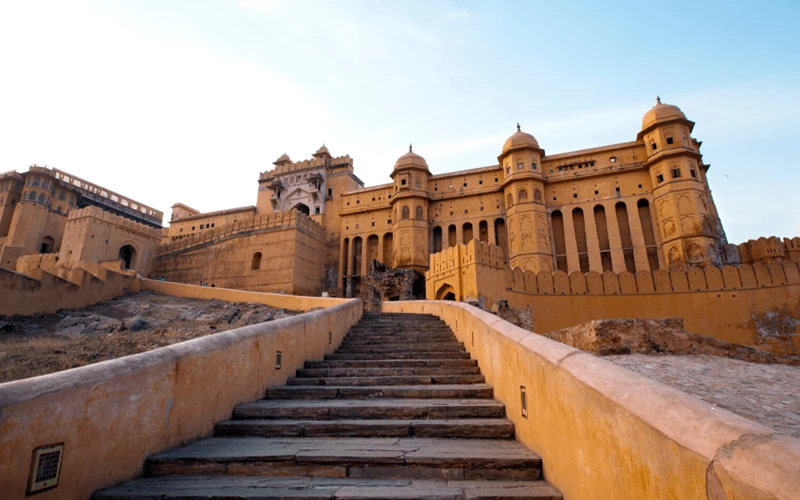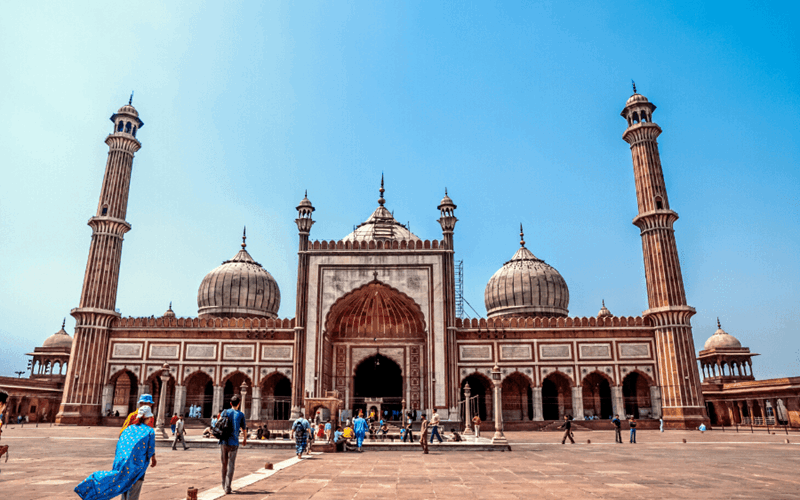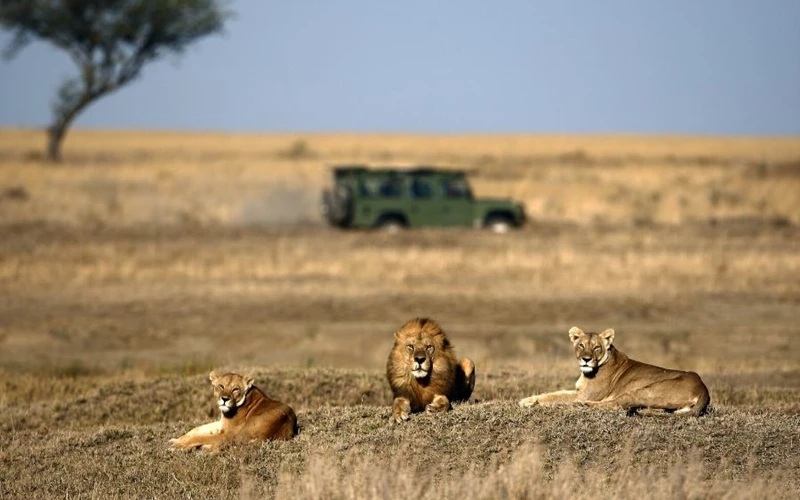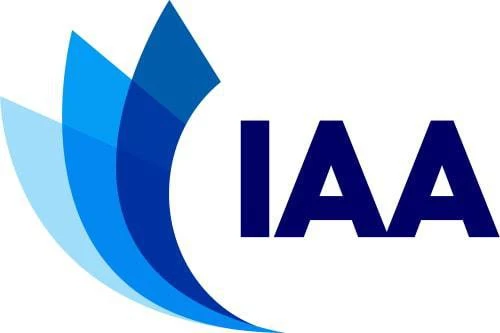What to expect on an India holiday
Georgina Willcox | 03 January 2023
India is a wonderful destination to experience, from exploring the exhilarating Old Delhi by rickshaw to a relaxing boat cruise on Lake Pichola, the regions of Delhi and Rajasthan in the north of India are home to some of the most impressive sights in Asia. Nenagh photographer Bridget Delaney recounts her memorable holiday to India with us on our Splendours of Delhi, The Taj Mahal & Rajasthan guided tour.
The warmest of welcomes
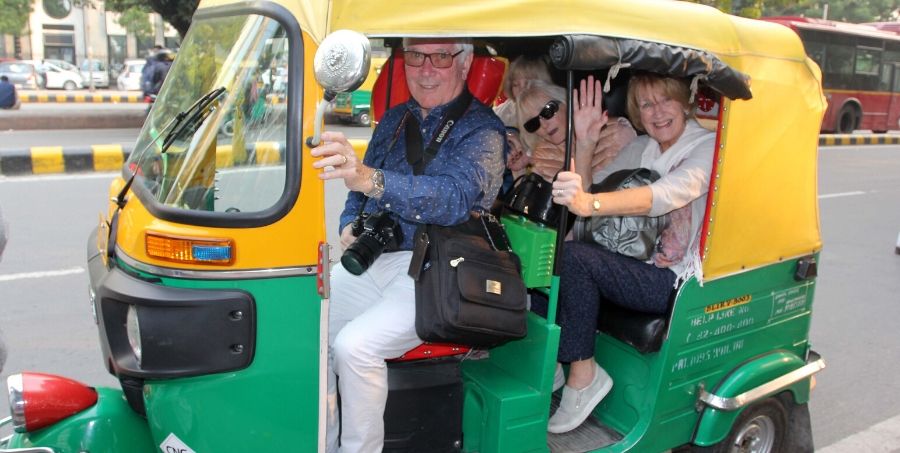
Tuc tuc mode of transport is regularly availed of by tourists.
"I recently travelled to India in the company of 37 others, all availing of the 'Splendour of India package' by Irish company, ‘Travel Department’. Dublin Airport was the departure point to Abu Dhabi and a connecting flight to Delhi with Etihad Airways accommodating our 11 hours in the sky. A Granted Visa is necessary to visit this country and it is a headache to fill out. A plane lands in Delhi Airport every three minutes so immigration clearance can be confusing and very time consuming. Our tour itinerary covered the Golden Triangle which is made up of Delhi, Agra, and the Rajasthan capital Jaipur, with the concluding days being spent at Jodhpur and Udaipur which are also in the Rajasthan state. Then an internal flight brought the group back to Delhi for one more night at the country’s capital city before our long journey home.
The country
India has a population of 1.3 billion and is the most populous democracy in the world with 416 people per square km. Delhi alone has a population of 25 million and our introduction to the capital city proved to be a baptism of fire. February is the best month to travel to these parts as temperatures vary from 23-26 degrees Celsius. People are everywhere with every mode of transport used - tuc tuc, rickshaw, motor bike, car, tractor, trucks, bus and anything goes really. Traffic is chaotic with right of way given to those who move first except in the case of a cow, who can cross the road at a slow pace, with vehicles making sure not to hit the sacred animal. The regional rail network is kept busy as are local buses which are often crammed with people availing of climbing ladders to find a free spot on the rooftop. It is a way of life to have marks and dents on vehicles, as bangs are considered normal and drivers are happy once they can continue on their journey. There is also a constant sound of horns honking all day long.
Some travel advice for India
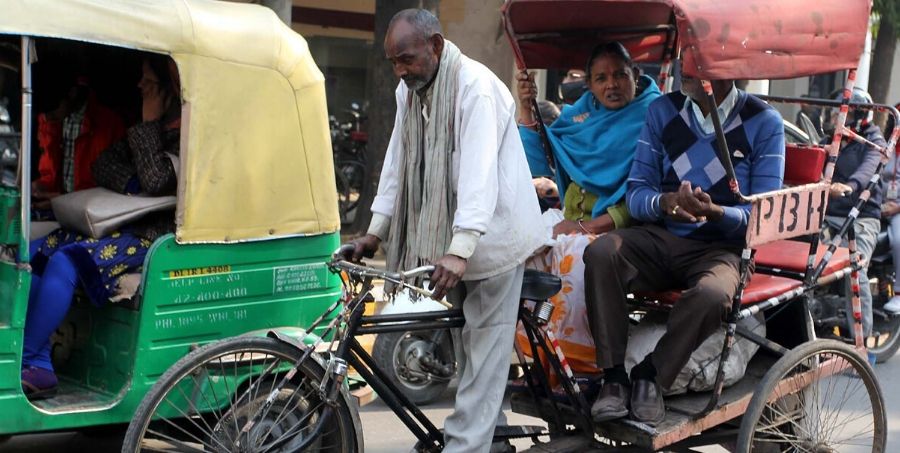
Space for everything is at a premium and shop fronts utilise this to maximum effect with most trading long business hours each day. The smog is not healthy, and this did cause breathing and respiratory problems for a lot our group. Tourists are told not to eat street food and to only drink bottled water. Public toilets take getting used to as they involve you squatting rather than sitting, while anti-bacterial hand gel is a must-carry at all times as are sunglasses. The visible electric wires appear chaotic on every street. Life is really a question of survival. I saw traffic lights at one big junction where some locals entertained, or were selling souvenirs to get a few Indian Rupees once traffic was stopped. Many sites were worth visiting, and these included a guided tour of Qutub Minar, the world’s tallest brick Minaret and Humayan’s Tomb, the Jama Masjid Mosque and bustling market of Chandni Chowk where spices, herbs, scarves and souvenirs could be purchased.
Mahatma Gandhi
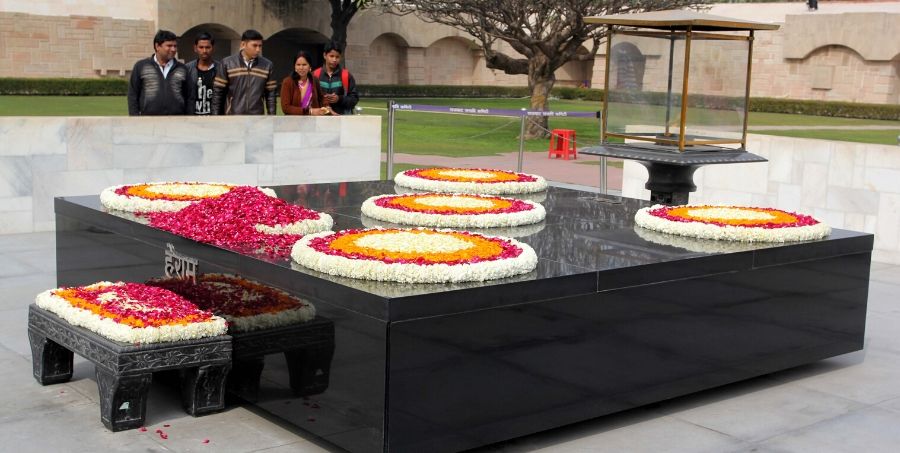
Raj Ghat is the memorial site for Mahatma Gandhi. This is his burial ground after cremation. He wanted his ashes to be spread on the river, but the people of India felt he deserved a special place.
I was moved hugely by the visit to Raj Ghat which is a memorial dedicated to Mahatma Gandhi. He was buried here after cremation. Many students of all ages were visiting the site with us and we were amazed with their perfect English and willingness to have a conversation. Mahatma Gandhi was a man that sought better conditions for the poor of India. Some of his inspirational words are engraved in stone on this spacious site that includes a lovely garden. The list includes : “A word uttered from pure heart never goes in vain”; “He who always treads only on the path of truth never stumbles” and, “In faith there is no room for despair”.
Taj Mahal
Agra was our next destination which took more than three hours by bus, with excursions to the impressive Agra Fort, which is a world heritage site, and a sunrise visit to the world famous Taj Mahal, about 3 kms from the city. The Taj Mahal is made of white marble in memory of the then Empress of India. The Royal Emperor Shahjahan’s third wife was named Mumtaz Mahal, who died giving birth to their 14th child and which left the Royal Emperor heartbroken. After a few temporary burial grounds for his late wife, the Mughal Emperor announced that a memorial would be built where she would be permanently buried. Famous architects of the world were invited to submit designs, with Ustad Isa Afandi of Turkey selected for the construction. The work commenced in December 1631 and finishing in the year 1648. Over those years, the completion of the building involved 20,000 labourers. Shahjahan spent the last seven years of his life as a captive in a section of Agra Fort under the instruction of his son, Aurangzeb, who felt that the high spending on the Taj Mahal restricted his inheritance. Shahjahan died looking over at the Taj Mahal from the fort and was buried beside the love of his life. Now tourists from all quarters of the world flock to see both graves in the interior of this most impressive tomb, which opens from sunrise to sunset with the exception of Friday when it is closed. At this amazing place, our party bumped into some fellow Tipp natives in David Creamer (Portroe) and Aine Cummins (Gortagarry).
Rural India
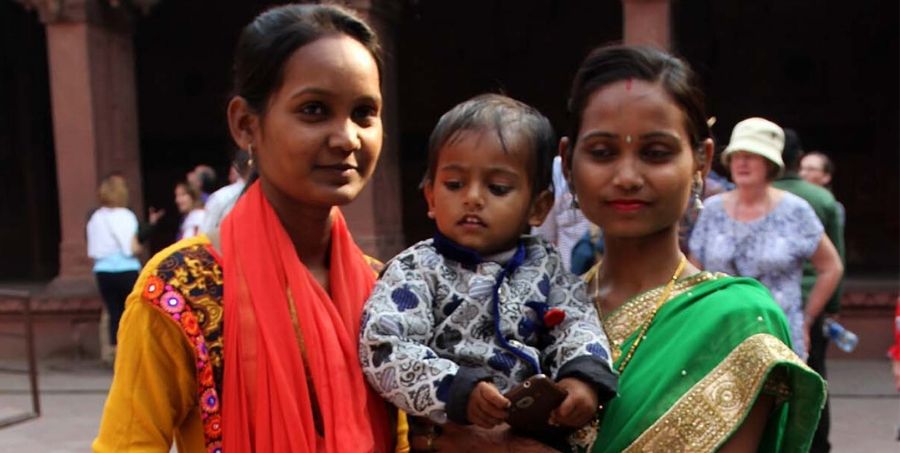
The ladies and children dress in vibrant colours.
Our next destination involved a long journey to Jaipur. En route we visited Fathepur Sikri which is now a deserted red sandstone city built by Emperor Akbar as his capital. Even though space is at a premium, the locals will not interfere with such sites, but nearby will try to feed their families by selling souvenirs. This involves the art of ‘haggling’ the price before a deal is struck, and they will always give back the correct change. A protest by locals saw us having to divert from the highway, leaving dozens of lorries parked behind while our driver showed his excellent skills navigating the many narrow roads and even dust paths. We now saw rural India in all its splendour. Women dressed in vibrant colours working in the fields, while many of the men sat in groups discussing the politics of the day, others reading newspapers. Cow dung patties were also visible, and - again - the women were moulding cow’s poop with hay into a circular format using their bare hands. The dung is then left to dry by placing it on top of their houses or stacked up. Cows are sacred, and their dung, once dried, is used to fuel fires for cooking or for some Hindu rituals.
Warm greetings
My everlasting memory will be the greetings from the natives to the arrival of tourists on a big bus in a remote area. They stopped their chores in the field to wave at us, parents holding up their young to get a better view and children jumping with excitement along the roadside. Towns and villages, which included Jamuwa Ramgarli, Raisa, Chandwaji and Shatwari, gave us receptions akin to a homecoming ceremony for a victorious team winning a prestigious tournament. Was this Ireland in the 1950s when life was just for living? Everyone seemed so happy without having a lot and were united with their own community. After being up at 5.15am to go see the Taj Mahal at dawn we did not reach our destination, Jaipur Marriott Hotel, until 10.30pm, but thankfully nobody suffered from the dreaded ‘Delhi Belly’ that day. Yes, this was a very special day for a privileged Irish group, and everyone knew it.
Beautiful Indian temples
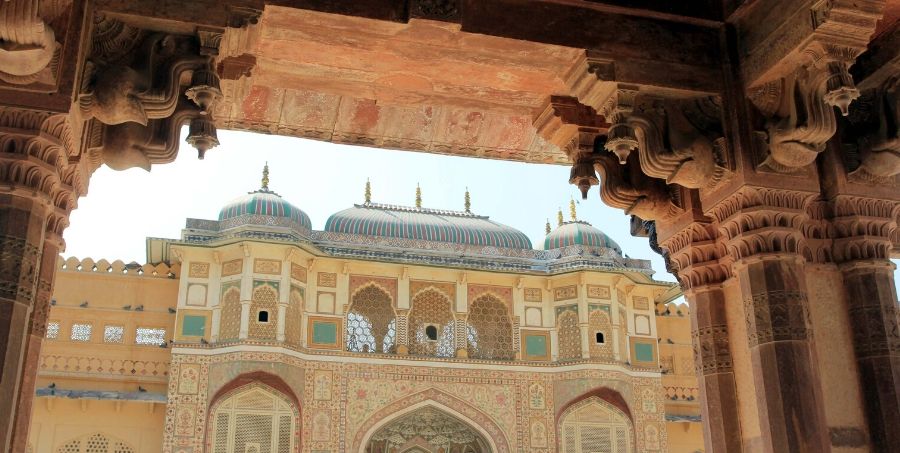
Amber Fort in Jaipur.
Jaipur (The Pink City) was founded by the great Warrior and Astronomer Maharaja Jai Singh II, who ruled between 1693 and 1743. The Rajasthan state capital has a population of 3 million. The Amber Fort overlooking the Maota Lake was spectacular, as was the City Palace Museum, Jantar Mantar and Hawa Mahal (Palace of Winds) in the city centre where, like the other places we visited, traffic was chaotic. Jodhpur was our next destination, a bus journey of over six hours that was shortened by viewing the activities of the locals en route as we watched their gentle style of living. Once again the women were hard at work while some of the male folk took life easy. Jodhpur (Blue City) is in the Thar Desert, situated in the north west of the Luni River and the home of the Rathore Rulers of the princely state of Rajasthan. The sites we visited were the Jaswant Thada and the Mehrangarh Fort where there is a spectacular view of the blue coloured buildings. The next day a seven-hour bus journey awaited us for our destination, Udaipur, and a stop en route to Ranakpur Jain Temple in the Aravalli Hill range. A local businessman started construction of this temple in the 15th century following a divine vision. In Jainism (like Buddhism) there is a belief in reincarnation which will eventually lead to liberation by following a life of purification. Jains will not eat root vegetables; they fast and worship their icons and will not listen to radio, mobile phones or TV. Udaipur (City of Lakes) is upmarket in comparison to other cities, and is also in the state of Rajasthan. Udaipur was founded by Maharana Udai Singh II in 1559 and has a series of artificial lakes. We visited the City Palace Museum, famed for its peacock mosaics and spectacular garden of Sahelion Ki Bari overlooking Lake Pichola.
Great adventure
It was wind-down time now with a boat cruise to Jag Mandir Palace, built on an island of the artificial Lake Pichola (also called Lake Garden Palace). An internal flight from Udaipur to Delhi brought us back on track and on the morning of departure we visited our final temple in Delhi. All these sites have their own characteristics and were well worth the effort of visiting as most of us will not pass this way again. Never say never, and our remarkable Tour Guide, Shyam, and his mighty team were deserving of generous tips for going beyond the call of duty. Many are curious with the purpose of a holiday in these parts, but I must say I loved every minute of the adventure and I will sign off with a quotation from Mahatma Gandhi which is inscribed at Raj Ghat Memorial site in Delhi - “Pure thought is far more potent than the spoken word”.
On this 11-night India holiday, we'll discover ancient palaces and monuments, proud fortresses, mosques and bustling cities. Plus with visits to the Taj Mahal and the magical city of Udaipur included, you will experience the very best of this fascinating country.
This article originally appeared in the Nenagh Guardian March 16th 2019 and all photos were taken by Bridget Delaney.
You Might also like
Inspiration by Country
Top Things To Do In India
- Georgina Willcox
- 22 July 2022
India is a dynamic nation with a deep cultural history that needs to be experienced with your own eyes. ...
Inspiration by Country
Everything you need to know about India's Golden Triangle
- Georgina Willcox
- 03 January 2023
The Golden Triangle is a classic introduction for any visitor to India. ...
Special Interests Inspiration by Country
7 Worldwide Wonders for Your Travel Wishlist
- Georgina Willcox
- 25 February 2022
Are you looking for some travel inspiration for your holidays? Travel has never been more accessible and now is the time to experience some of the most iconic attractions in the world. ...








